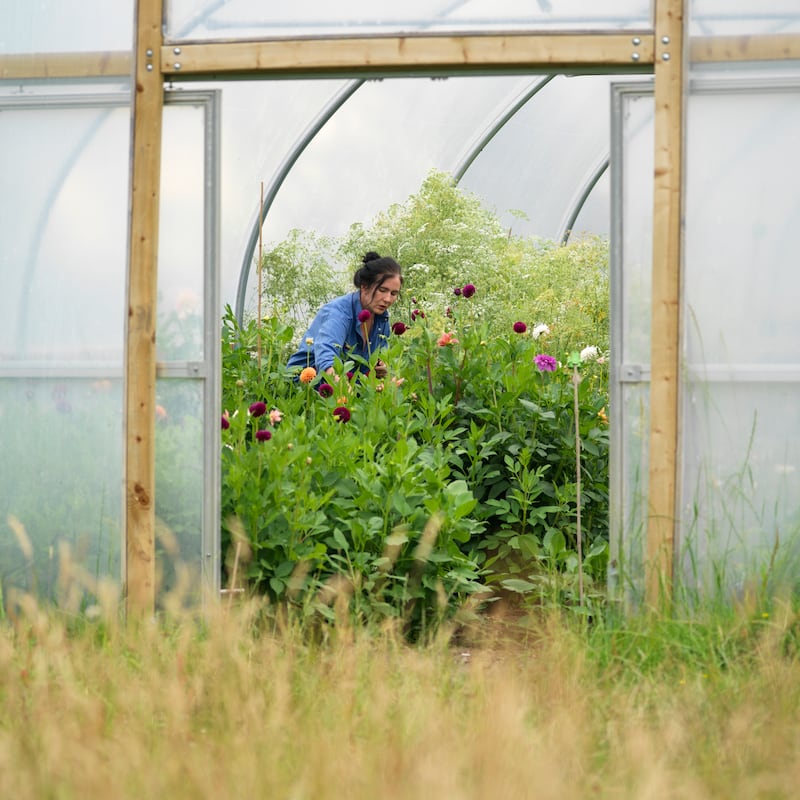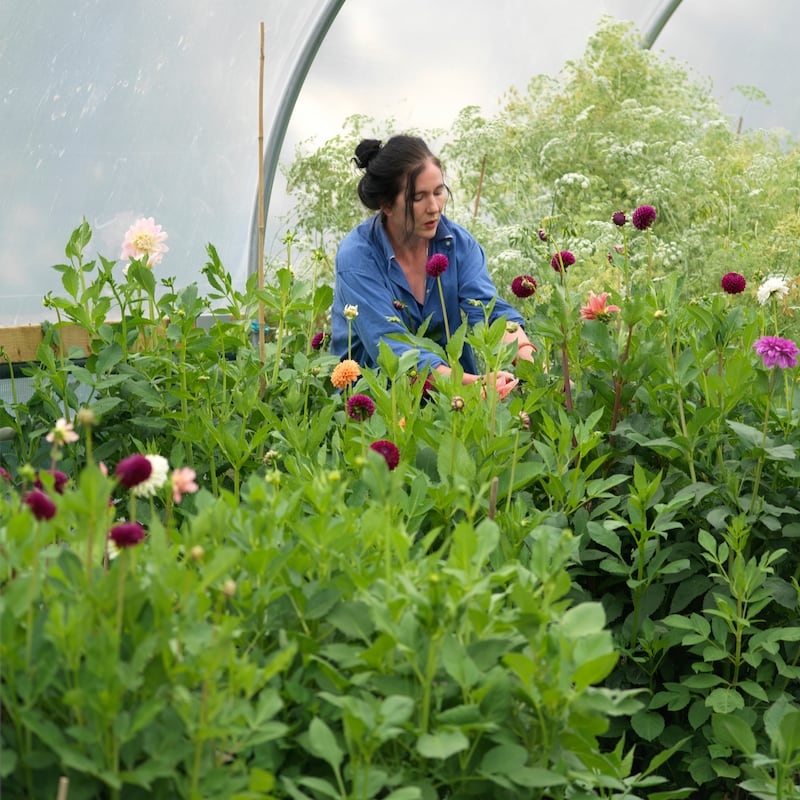History doesn’t tell us who first figured out that by stretching a skin of taut, transparent plastic over a series of rigid, vertical steel hoops, you could create the sort of protected growing environment that tender or heat-loving plants would love. But on behalf of all polytunnel owners, I’d like to express my undying gratitude. It’s because of their inventiveness that my courgette plants are plump and leafy, my cucumbers properly productive and this year’s tomato harvest guaranteed. Their ingenuity is the reason why my polytunnel-grown dahlias have been in bloom since early July, my ornamental carrot plants (a very lovely cut-flower variety called Daucus ‘Dara’) remain unscathed by carrot fly, my roses (also grown for cutting) untouched by blackspot.
Being able to garden in my polytunnel has also helped to save my sanity during what must be one of the strangest and most sodden of Irish summers in living memory. On those grey, cold, rainy days when there’s been little joy to be had in working outdoors, it’s offered warmth, seclusion and a leafy refuge.

Of course their many charms aside, polytunnels are also valuable pieces of real estate where every square metre of precious growing space should - ideally - be used throughout the year. So while it may feel far too early to be talking of autumn, winter and early spring crops, now is the time to start planning ahead if you want to ensure that your polytunnel remains properly productive throughout the darker, colder months to come.
What to sow and grow? Suitable crops for sowing over the coming weeks, either into pots/modules for transplanting into the polytunnel as young plugs or for sowing directly into well-prepared beds, include many different kinds of leafy vegetables such as Swiss chard, perpetual spinach and hardy varieties of lettuce. Examples of the latter include ‘Winter Density’, ‘Winter Marvel’, ‘Jack Ice’, ‘Reines des Glaces’, ‘All the Year Round’, ‘Lettuce Winter Imperial’, ‘Arctic King’ and ‘Valdor’; just remember to avoid sowing lettuce during very hot weather to avoid problems with germination.
Other eligible candidates include spring cabbage, kale (try ‘Nero de Toscana’ or ‘Ragged Jack’), rocket, mizuna, mibuna, lamb’s lettuce/corn salad, pak choi, texel greens, winter purslane/claytonia, landcress, oriental leaf mixes and many kinds of herbs including dill, parsley, chervil, sorrel and coriander. Most of the above can be treated as cut-and-come again crops and will be productive over a long period so long as you only pick small quantities of leaves from each plant when harvesting.
Other vegetables suitable for sowing/growing in your polytunnel in the coming weeks include beetroot, kohl rabi, Florence fennel, sprouting broccoli, broccoli raab, potatoes (the ‘early’, fast-cropping varieties), dwarf French beans, radishes, spring onions, turnips (try ‘Milan Purple Top’ and ‘Tokyo Cross’). Fruits include the everbearing/day-neutral varieties of strawberries such as ‘Albion’.
Adventurous kitchen gardeners might also like to take a leaf out of the blog of well-known Irish polytunnel grower and broadcaster Nicky Kyle (nickykylegardening.com) by growing the saffron crocus (Crocus sativus), whose edible scarlet flower stigmas are traditionally used to add colour and flavour to rice and seafood dishes. For best results, plant its fast-growing bulbs (available to order from fruithillfarm.com) between August-September, 10cm-deep and into a pot filled with a very free-draining compost lightened with plenty of horticultural grit (take suitable precautions against mice). The bulbs should start blooming by October-November, at which point those three long, scarlet stigmas in the centre of each purple, cup-shaped flower should be harvested daily and carefully dried for later use.
Sowing flowers
August is also an excellent time to sow seed of some hardy flowering annuals and biennials (under cover and into modules/seed trays/pots) such as Orlaya grandiflora, Ammi majus and the aforementioned Daucus 'Dara' for transplanting as young plug plants into your polytunnel in September/October. All of these will give very early, pest-free, generous crops of beautiful pollinator-friendly cut-flowers from late spring/early summer. So will ranunculus (Ranunculus asiaticus) and anemones (hybrid varieties of Anemone coronaria), two outstanding types of cut-flower which pump out their gloriously beautiful spring blooms for five to six weeks when grown undercover with each single plant producing up to 20 flowers. Both are available as tubers/corms to order online from Dublin-based mrmiddleton.ie and UK-based sarahraven.com (the latter via Parcelpost or An Post's AddressPal service).

For best results, plant ranunculus and anemones into the polytunnel no later than the end of September/early October. Before planting, make sure to pre-soak their shrivelled-looking tubers/corms in a bucket of tepid water overnight to rehydrate them; you’ll be amazed by how much they swell and plump up. Then place them, spread out, into a flat-bottomed tray of damp compost generously lightened with perlite, making sure to cover them completely. Place the tray in a cool (4C-10C) and rodent-proof spot (mice and rats love to steal anemone corms) for one to two weeks, regularly checking it for obvious signs of growth. Once you spot baby roots and new shoots appearing, then it’s time to gently move the tubers/corms to their final growing position.
For ease of maintenance, plant in rows to a depth of 5 – 7.5cm, spacing each plant 15cm apart. Or to really maximise growing space, plant into flat trays/shallow boxes; these can then be moved outdoors in spring as the weather improves, freeing up space for other crops. Always water your newly-planted ranunculus and anemones regularly enough to keep the soil just slightly damp until they burst into active growth in early spring, at which point you should increase the watering and start giving them occasional liquid seaweed feeds. By early March you’ll be picking armfuls of blooms for you and your lucky friends and family to enjoy.
Good housekeeping
Last but not least, a few words about good housekeeping. Whichever vegetable, herb or cut-flower crops you decide to grow in your polytunnel over the coming months, it’s crucial to do everything you can to support soil health and fertility and prevent a build-up of weeds, pests and diseases. So get in the habit of always spreading a layer of organic mulch (well-rotted manure, garden compost) before replanting; practice careful crop rotation; gently clean down that plastic skin at least once a year; quickly handpick/collect/remove and bag any dead, dying or obviously diseased plant material; avoid overwatering; always ventilate well on any bright, mild days; and keep a watchful eye out for common pests such as red spider mite, botrytis, powdery mildew, slugs, snails and rodents. Use an oscillating hoe to strike down baby weed seedlings before they become a problem and invest in a roll of horticultural fleece to protect any vulnerable crops in the event of an especially icy spell of weather. When that cold weather does eventually come, don’t forget that a sunny winter’s day spent gardening under the protective, transparent carapace of your polytunnel is every bit as good for you – just think of all that Vitamin D – as it is for your plants. Like I said, eternally grateful. . .
Dates for your diary
From Monday, July 27th, Helen and Val Dillon are reopening their garden at Dun Mhuire, Seafield Avenue, Monkstown, Co Dublin to the public. Viewings per week are strictly limited with a maximum of 10 people per group, pre-booking essential, please see dillongarden.com or call 01 2148740 for details.
Frances and Iain McDonald, owners and creators of the Bay Garden in Camolin, Co Wexford, have also reopened their country garden to small pre-booked groups (maximum of one to four people) this summer. See thebaygarden.com for details or call 086 8436624.
While the annual fundraising Rathmines Open Gardens event won't take place this year, its organiser Rathmines Initiative has responded innovatively to the challenges of Covid-19 with the creation of the Rathmines VIRTUAL Open Gardens 2020 featuring a selection of professionally filmed videos of participating gardens by video-maker Paul Quinn. To see a teaser video and/or donate (the requested donation is €10 with all donations split evenly between the Rathmines Initiative and the Rathmines Conference of the Society of St Vincent de Paul), log on to gofundme.com/f/210mxk4plc.











